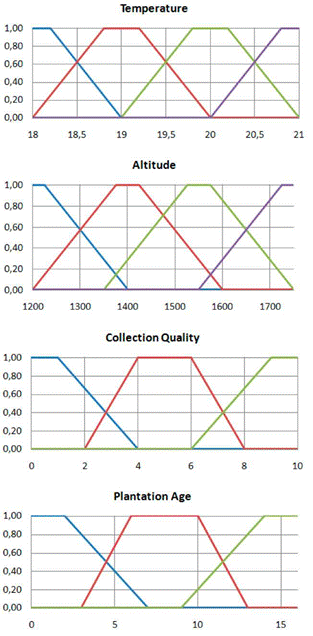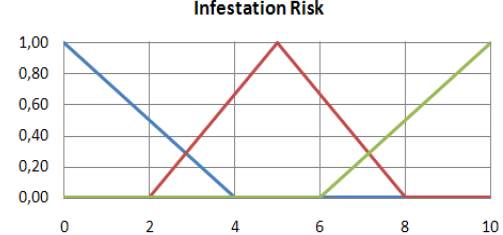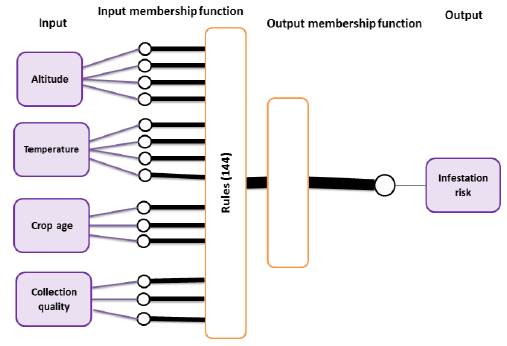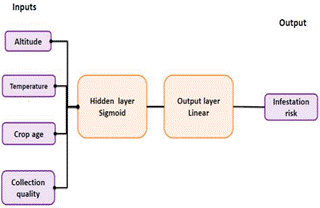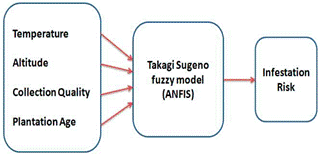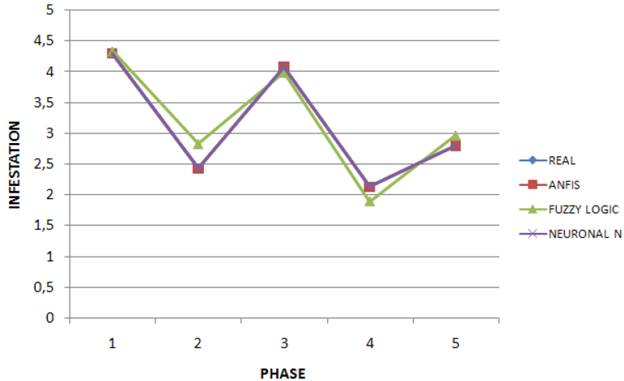1. Introduction
Despite the importance that coffee represents as one of the most important export products for Colombia [1], it is a product that has been largely affected by the coffee berry borer CBB, where it has reduced production due the increased pest infestation [2] [3].
Reducing pest effect on the coffee plantations has adopted various techniques and processes [4]. Pn the other hand, previous studies on this subject have focused primarily on control [4], growth and mortality [5] of coffee berry borer, identifying certain variables and conditions that favor its existence [6] [7].
With this in mind several models have been developed targeting the identification of the main variables that affect infestation level, in relation with certain conditions in the coffee crops and its environment. The models are:
As previously cited, in preliminary works, implementations were undertaken with prior techniques, particularly in [8] where a fuzzy optimization model was proposed to represent the coffee berry borer expansion in coffee plantations.
Moreover, [9] and [10] proposed neuro-fuzzy systems by using ANFIS representing the expansion of the coffee berry borer. In addition, in [11] a neural networks model can be observed representing the coffee berry borer spread.
Consequently, the purpose of this paper is to compare prior techniques to establish which of those can be the most relevant to representing the berry borer spread in coffee plantations in Colombia.
Additionally, other works have developed swarm particle model applications to simulate the coffee berry borer spread in plantations of coffee [12]. Using a virtualization strategy, a quick and efficient performance in such simulations is obtained [13]. The swarm intelligence results an interesting technique due to the existence of different behaviors, highlighting some insects, birds and fish, which present pattern motions for their survival as to protect against predators, finding food, energy saving swimming or flying together [14]. These behaviors are possible due to global messages of individuals [15]. In the case of coffee borer, the female, to move from one fruit to another, checks if it has been perforated [16].
In addition, it can be said that this project corresponds to the application of computational intelligence techniques for the solution of ecological problems in the national environment; another example of this can be seen in [17] where it is made identification of eight bird species of Bogotá wetlands, using pattern recognition.
2. Model variables
With regard to studies by Colombian agricultural entities, four variables were considered relevant to achieving the models. All models handle the same four input variables.
The temperature is one of the most important and favorable factors for the coffee berry borer expansion [18]. Insects need ideal moisture conditions, this is why places with prolonged periods of rain can prevent fly; on the other hand, warm places or areas with rain-sun transitions have ideal conditions. 'CENICAFÉ' has identified certain levels of action of the CBB, respect to some temperatures, having:
Average temperature 21°C
Average temperature between 20 °C and 21° C
Between 19° C and 20 °C
Temperature < 20°C
As well as the temperature favors the spread of the pest, altitude is quite related to this variable because higher altitude areas have a lower average temperature. Likewise, lower altitude has associated higher average temperature, which favors plague spread [7].
As the plant becomes older, increases the number of fruits that remain uncollected in it, raising the possibility of pest spread.
The amount of fruit left in each plant has qualified for the MIB (19) having a good, fair or poor quality. The ranges are handled (per tree):
Including all kinds of fruit (ripe, green), branches and soil. This factor increases the possibility of migration, females seek new fruit to drill present on the ground.
In addition to the independent justification of the variable, it relied on the analysis that has been done by the state in MIB reports (Integrated Management of Berry Borer), which includes the same variables as analysis and data are illustrated by department (highlights again the altitude) in five years (1998-2002) [19].
For the output (Risk) the maximum value range is 10, considered as 100 percent infestation; hence each unit is about ten percent of this infestation risk.
3. Fuzzy model
Knowing the variables used, the model description is brief; considering the factors (variables) described above, system inputs are shown in Figure 1, having a set of rules (144) governing possible combinations (the most important ones) that significantly affect the output variable. The expected output is the level of risk of infection, as shown in Figure 2.
4. ANFIS Model
The neuro fuzzy model proposed starts generating a fuzzy model without training. The initial four nodes (called entries) correspond to variables of temperature, age of the culture, and harvesting quality altitude. These variables are described by their respective membership functions that are represented by white nodes, varying with the amount of functions related (temperature is handled through four nodes) then, the neuro-fuzzy model is trained, adjusting their membership functions according to each case chosen (department) respect to data used. The set of rules to guide its performance is 144, ultimately affecting the output function corresponding to the risk of infestation of the CBB (Figure 5), and generating a structure of neural network with 323 nodes and 186 parameters, seen in Figure 3.
5. Neural Network Model
A neural network was designed with two layers, the first has 144 neurons equivalent to 144 rules that were used in the previous fuzzy rapprochement, which had favorable results, justifying the choice of this number.
Four initial nodes called entries (Figure 4) correspond to variables of temperature, culture age, height and quality of harvest, which were also chosen by the results obtained with fuzzy and neuro fuzzy technique. The output represents the risk of infestation of the coffee berry borer, which is expected to conform to actual data, since the network is trained with the data, with 200 training periods.
Of the coffee berry borer, which is expected to conform to the actual data, since the network is trained with the data, with 200 training periods.
6. Data Comparison
Initial data for comparison of the different techniques discussed here are determined by data collected by 'CENICAFÉ' for the years 1999-2002, in Tables 1 and 2 data supplied to the departments of Antioquía and Caldas are presented, which are taken as input, and the output is discussed below for each model.
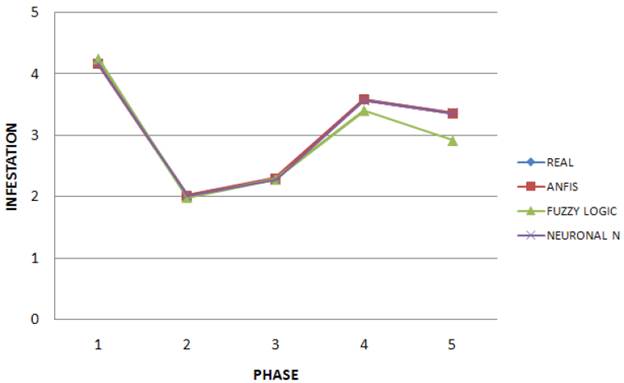
Figure 6 Comparison of the results obtained for the various techniques for the department of Antioquia.
7. Results
In Tables 3 and 4, outputs are compared shown error obtained by each one of the models for data taken from Antioquia and Caldas. Figure 6 and 7 plotted comparison data, verifying the proximity of various techniques to real data. In this result the fuzzy model was found the least precise.
8. Conclusions
The performance of these techniques used to model the behavior of the CBB in coffee fields has proven to be satisfactory. The techniques called supervised (fuzzy model, neural networks and ANFIS) achieved adjustment for input data, emphasizing the accuracy of the techniques that have adaptive component.
Supervised techniques searches adjustment to input data and in the specific case of neural networks this technique had the best performance allowing to verify that variables chosen were appropriate. In addition, identifying the viability of these variables allowed to develop an additional model of particle swarm, whose comparison will be included in a future work.
Finally, although the technique with the best performance was neural network, results of other techniques are considered acceptable.













